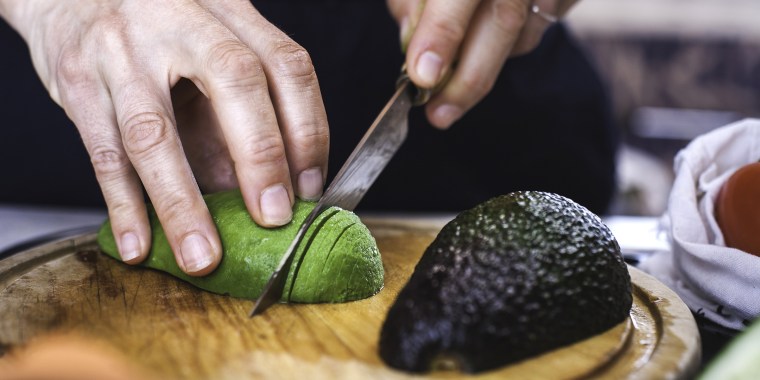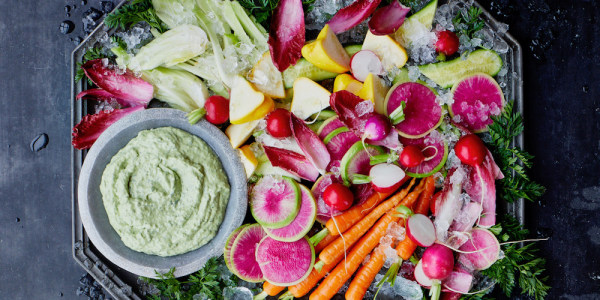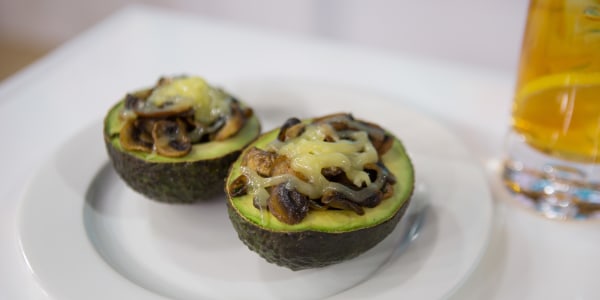The dreaded "avocado hand" isn't the only bad thing that can happen when cutting open an avocado.
That's why we're brushing up on avocado dos and don'ts before whipping up avocado toast for Sunday brunch this weekend. For starters, if your avocados aren't ripe enough, here are a few tips and tricks that will help them soften up quickly. And when it's prep time, make sure to avoid the emergency room by slicing them safely.
While many folks may feel confident that they know all the techniques to keep guac green, there's one unlikely player that may be expediting the green fruit's browning process: a knife.
According to chef Hervé Malivert, Director of Culinary Arts and Technology at the International Culinary Center, any stainless steel knife commonly used by home cooks is not the best for cutting avocados.
"The material in a metal knife may help to oxidize the avocado and ripen it [more quickly]," Malivert told TODAY Food. "A ceramic knife would be better because it doesn't rust."
The components in many metal knives, such as copper and iron, can cause the knife to rust, which may lead a fleshy fruit, like avocado, to brown faster once it's exposed to oxogen.
But don't go throwing out the whole stainless steel knife set, avocado fiends.
Sandy Sauter, Executive Chef of Public Programs at the Culinary Institute of America in California, told TODAY that when it comes to cutting avocados, she hasn't experienced more browning when using a stainless steel knife. However, she would love to see a scientific study comparing knives. She reiterated that using a sharp knife is what really matters. "I tend to use a chefs' knife so that it is large enough to cut all the way around the seed in one motion, giving a clean cut to the flesh," said Sauter.
Ceramic knives — which are very sharp — are beloved by many home cooks because they make precise cutting easier and work well on tender foods like fruit, many vegetables and fish. But that material, which is prone to chipping, is not good for everything.
"Steel is better for butchering and ceramic is better for fruits," Malivert told TODAY. "Just like a cutting board, you want your knife for your meat and one for your fruits and vegetables. Ceramic knives are more clean and hygienic and very, very easy to clean. Metal and steel are more porous."
While a ceramic knife may not cut it when it comes to tougher meats or frozen foods, it does not absorb odors or bacteria in the same way steel does, according to Malivert. That means the same knife can be used to cut an onion, rinsed with some warm water, and then be used right away to cut up a sweet fruit with no lingering smell or taste.
A great set of stainless steel knives will likely last you for a long time but, even though that gorgeous set serves many useful purposes, it may be time to expand the collection with a solid ceramic knife. Malivert advised consumers to look for knives labeled as "100%," "fine" or "advanced" ceramic, otherwise it may be mixed with other elements that make it cheaper, but less sturdy and effective.
For cutting avocados and other fruits and vegetables, Malivert recommends buying no bigger than a 7- to 8-inch blade.
"I tell my students, a knife is personal, so you want a knife that feels good to you" Malivert added. "Some people like 10- to 12-inch blade[s] but for small types of fruit like avocado, a pairing knife is perfectly fine — around a 4- to 5-inch blade."
Regardless of what type of knife you're using, be sure to adhere to the proper slicing and dicing tips from the experts at the Haas Avocado Board and the California Avocado Commission:
- Put a dish towel under your cutting board. Or use something similar to prevent slipping.
- Wash the avocado, then lay it on its side. Make sure the surface is clean and free of any dirt. And always make sure to use a ripe avocado — they'll be softer and tastier.
- Hold the avocado securely with one hand on top. Keep those fingers out the way.
- Cut it lengthwise around the seed. Using your other hand, rotate the fruit slowly around the seed until you get to the other side.
- Twist and rotate. Use a spoon to scoop out the pit and discard. Now you can scoop out chunks of the creamy, green flesh or score it to make cubes.
Even though a browning avocado may not be as great of a travesty as a gory kitchen accident, it's still enough to make that spread of chips and guac look a little lame at any party.
But hey, if all else fails, enjoy a this creamy guacamole-flavored cheese instead. It might get a little moldy, but it won't be getting brown anytime soon.





